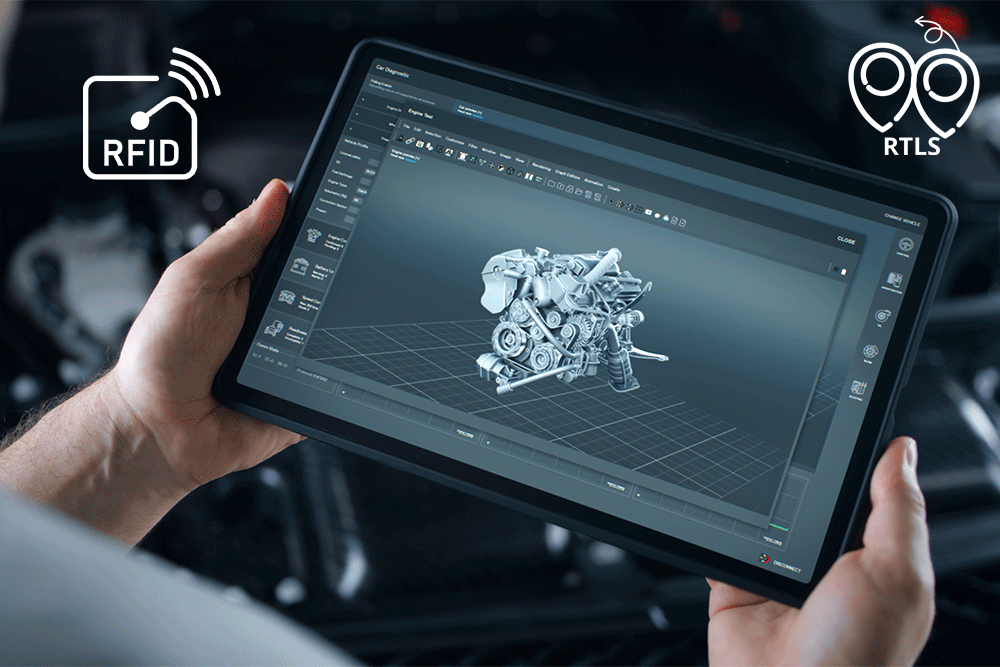In the realm of auto and auto parts manufacturing, efficiency is paramount. Every movement, every asset, and every process must be meticulously tracked and managed to ensure seamless operations and optimal productivity. This is where tracking solutions such as Radio Frequency Identification (RFID) and Real-Time Location Systems (RTLS) come into play, offering invaluable tools for streamlining workflows and enhancing visibility across the manufacturing floor.
 Understanding the Differences
Understanding the Differences
RFID and RTLS are often used interchangeably in discussions, but they serve distinct purposes and offer unique capabilities.
RFID utilizes electromagnetic fields to transfer data wirelessly between a reader and a tag, allowing for the location of objects or people. There are three primary types of RFID technologies—active, passive, and battery-assisted passive—each with its own set of functionalities and limitations. Passive RFID, for instance, relies on specialized readers to detect tagged items within close proximity, while active RFID tags continuously transmit signals to readers, enabling close-to-real-time tracking across larger areas.
On the other hand, RTLS solutions are designed to automatically identify and track the location of assets, individuals, or objects in real-time as they move through a confined area, such as in manufacturing facility. These systems employ various tags, badges, platforms, and network appliances to provide continuous visibility and monitoring, helping manufacturers optimize processes and improve efficiency.
 Choosing the Right Solution
Choosing the Right Solution
When deciding between RFID and RTLS for manufacturing, several factors must be considered:
- Tracking Capabilities: RTLS offers continuous monitoring and precise locating in real-time, whereas RFID provides point-in-time visibility or last-seen data points.
- Range: RTLS solutions typically cover larger areas than RFID systems, making them ideal for tracking assets across expansive manufacturing facilities.
- Accuracy: RTLS systems can provide certainty-based location accuracy, while RFID accuracy diminishes with distance from the reader and is susceptible to signal interference.
- Materials: RFID waves have a habit of bouncing off of reflective materials like metal, leading to inaccurate location information. RTLS uses technology like Bluetooth Low Energy (BLE), making its data more accurate.
- Scalability: RTLS solutions are designed to be highly scalable, allowing organizations to expand and adapt their tracking capabilities as needed.
- Purpose: RFID is well-suited for inventory management and entry/exit tracking, while RTLS excels in time-sensitive locating needs, such as locating staff and optimizing workflow efficiency.
- Solution Integration: Due to its scalability, RTLS enables seamless integration with existing systems, infrastructure, and workflows, ensuring minimal disruption and maximum efficiency.
Overall, RTLS provides a more comprehensive and versatile solution for asset tracking and location-based services, making it better suited for auto and auto parts manufacturing compared to RFID.
Empowering Efficiency with TRACE Sensors
At i-Virtualize, we understand the critical importance of efficiency in manufacturing. Our TRACE Sensors RTLS technology offers unparalleled accuracy, reliability, and real-time visibility, enabling manufacturers to optimize operations, streamline workflows, and enhance productivity. Built on a Cisco network backbone and powered by Quuppa, TRACE Sensors enables you to track assets, monitor processes, and improve overall efficiency, leading to increased customer satisfaction and profitability.
Take your facility’s efficiency to the next level with TRACE Sensors.





